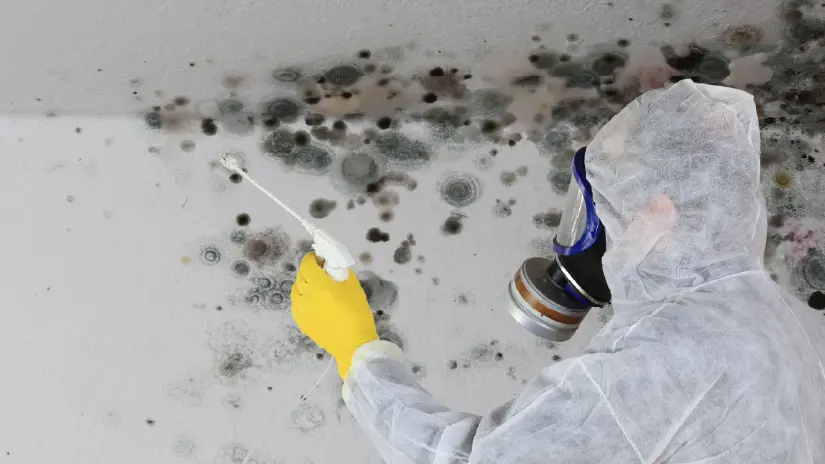
According to Rainbow Restoration, mold identification is crucial for maintaining a healthy home environment.
|
If your home or business has unusual marks on the wall or a suspicious musty scent, it could be an early sign of mold growth. In such cases, proper mold identification is imperative for protecting your property and the health of its inhabitants.
Many factors contribute to mold growth, from a simple water leak to poor ventilation, and different mold types may require unique treatment and remediation.
This guide covers several common types of mold, what they look like, and the potential health concerns they present. Although the guide provides a general overview of potential mold issues, definitive identification and the safe eradication of mold can only be guaranteed through the services of professional mold inspection and remediation services.
Table of contents:
Types of Mold
Although black mold often steals the spotlight due to its prevalence and potential toxicity, it's just the tip of the iceberg. There are a range of other molds that carry their own risks.
According to the Centers for Disease Control and Prevention, the most common indoor molds are:
- Stachybotrys chartarum (black mold)
- Alternaria
- Cladosporium (black-colored mold)
- Penicillium
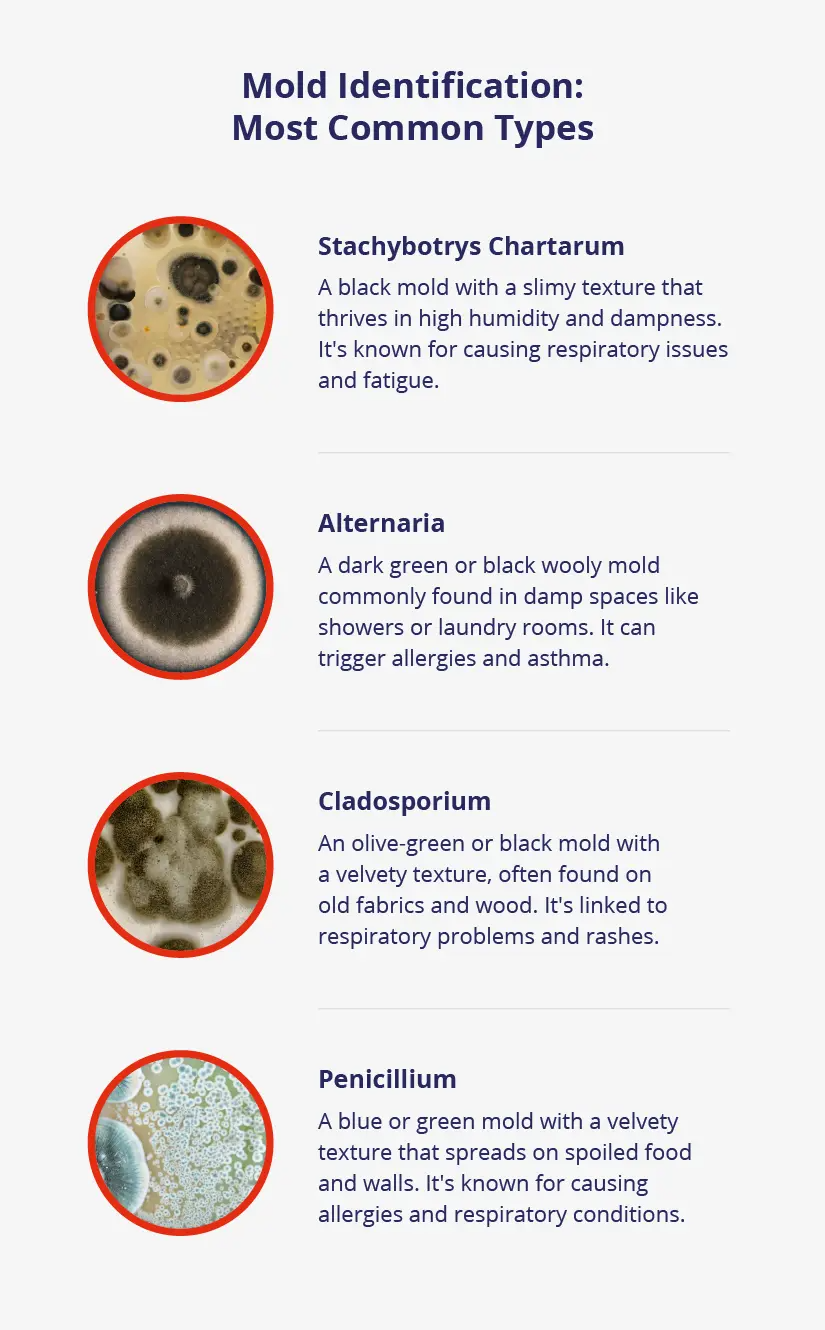
Continue reading for a more in-depth look at the diverse types of mold, how they grow and spread, and what potential health risks they carry.
1. Stachybotrys Chartarum (Black Toxic Mold)
Stachybotrys chartarum, commonly referred to as black mold, is the most toxic mold type. It usually emits a musty odor and grows in damp areas of a home or business.
What to know about Stachybotrys chartarum:
- What does it look like? Stachybotrys chartarum is black in color and has a slimy texture. It also produces a noticeably musty odor, which is a warning sign that it’s growing nearby.
- Where does it grow? Stachybotrys chartarum typically grows in places that are constantly moist, such as shower tiles, around leaky pipes, or in areas that produce frequent condensation.
- How does it spread? Mold releases spores into the air, which can then be absorbed through the skin or by inhalation.
- What health problems are linked to black mold? Of all common molds, black mold is linked to the most health problems. Exposure can cause hay fever-like symptoms (including runny nose, nasal congestion, watery eyes, sneezing, coughing, itchy throat, and sinus pressure), asthma attacks, sinus infections, and even fatigue and depression. Young children, the elderly, and those with respiratory problems or immune system disorders are particularly susceptible to health problems caused by exposure to black mold; however, most people will experience a reaction of some sort if exposed to mold.
2. Alternaria
Alternaria is most prevalent in warm, dry climates and can potentially cause serious respiratory problems such as asthma.
What to know about Alternaria:
- What does it look like? This type of mold is dark in color and has a downy or wool-like texture.
- Where does it grow? While it’s considered one of the most common outdoor molds, Alternaria also grows indoors. It likes damp spots (e.g., showers and under leaky pipes) but also thrives in areas with minimal moisture, such as in ductwork or upholstery.
- How does it spread? Alternaria spreads primarily through the release of airborne spores. These spores can be carried by the wind or through air currents indoors, particularly when the mold or its food source is disturbed. When the spores find a suitable damp environment, they can germinate and start a new mold colony.
- What health problems are linked to Alternaria? This mold is one of the most likely to cause allergic reactions. Hay fever-like symptoms typically follow exposure to Alternaria — and it may cause individuals to develop asthma over time.
3. Cladosporium (Black-Colored Mold)
Regarded as one of the most common outdoor molds, Cladosporium also has the propensity to invade indoor environments, especially properties with poor ventilation and excess humidity. Often mistaken for toxic black mold due to its dark color, Cladosporium is actually a different type of mold with unique characteristics and lesser health risks compared to Stachybotrys chartarum (toxic black mold).
What to know about Cladosporium:
- What does it look like? It's typically olive green to brown or black in appearance, with a velvety texture.
- Where does it grow? Cladosporium usually begins growing outside on plant material and enters the house through open windows and doors. Once inside, Cladosporium colonies may form on wooden surfaces, carpeting, insulation, bathroom ceilings, wallpaper, foundation walls, and other surfaces in rooms with poor ventilation.
- How does it spread? Cladosporium spreads through airborne spores. These spores can travel through the air, especially when the mold is disturbed, and settle in new areas with moisture.
- What health problems are linked to Cladosporium? Respiratory issues such as coughing, sneezing, itchy eyes, and a runny nose are common symptoms. In addition, Cladosporium can cause dry skin, and in some cases, an allergic reaction in the form of a rash may occur if it comes into direct contact with the skin. However, this mold is really only a problem for those specifically allergic to this species.
4. Penicillium
Penicillium is the most common fungi found in the environment and is typically considered non-life-threatening to healthy humans. However, those with weak or compromised immune systems should stay away from it.
What to know about Penicillium:
- What does it look like? Penicillium is green or blue and has a fuzzy texture.
- Where does it grow? This mold loves to grow on rotting foods and fabrics, from bread and cookies to mattresses and couch cushions. It also feels at home growing on insulation, carpet, and wallpaper — and spreads rapidly from place to place. Penicillins, a group of antibiotics, are made from Penicillium mold.
- How does it spread? Penicillium spreads through airborne spores. These spores can become airborne when the mold or its food source is disturbed, allowing them to travel to new areas. When these spores land on suitable surfaces with moisture, they can start a new mold colony. With the right conditions, the mold can then proliferate rapidly.
- What health problems are linked to Penicillium? Exposure to this mold can cause sinus infections, lung inflammation, and hay fever-like symptoms
5. Cryptococcus Neoformans
Cryptococcus neoformans is a potentially life-threatening fungus, notably affecting those with compromised immune systems. The mold thrives in soil worldwide, often in association with bird droppings, particularly pigeon guano.
What to know about Cryptococcus neoformans:
- What does it look like? This mold appears creamy to light brown and has a distinct yeasty texture.
- Where does it grow? It is predominantly found in soil, especially in areas enriched with pigeon droppings.
- How does it spread? The fungus is transmitted to humans through inhalation of the airborne yeast cells.
- What health problems are linked to Cryptococcus neoformans? Inhalation can lead to cryptococcal meningitis, a serious infection of the brain and spinal column, especially in people with weakened immune systems.
6. Histoplasma Capsulatum
Histoplasma capsulatum is a mold found in regions with a large population of birds and bats. It becomes dangerous when its microscopic spores become airborne, potentially leading to histoplasmosis, a respiratory disease that can spread to other parts of the body.
What to know about Histoplasma capsulatum:
- What does it look like? It's small and tubular in shape and often brownish in color.
- Where does it grow? This mold predominantly thrives in soils rich in bird or bat droppings, especially in Midwestern states along the Ohio and Mississippi River valleys.
- How does it spread? The spores become airborne when the soil is disturbed. Humans get infected when they inhale these airborne spores.
- What health problems are linked to Histoplasma capsulatum? Histoplasmosis can range from mild, flu-like symptoms to more severe infections, affecting the lungs, and, in more serious cases, spreading to other parts of the body.
7. Trichoderma
Trichoderma is commonly found in agricultural settings due to its ability to promote plant growth and health. However, some species produce potent mycotoxins and are pathogenic to humans.
What to know about Trichoderma:
- What does it look like? Trichoderma molds are often white with a green patch or spore mass in the center. The texture may vary, but it often looks wooly or cottony.
- Where does it grow? They are most commonly found in soil but can also grow on wood and other organic materials, especially if they are damp or wet
- How does it spread? Trichoderma spreads through the production of large numbers of lightweight spores that are easily dispersed by air currents.
- What health problems are linked to Trichoderma? Some species are known to produce potent mycotoxins that can be harmful if ingested, inhaled, or come into contact with skin. Symptoms may include allergic reactions, sinus infections, and respiratory issues.
8. Acremonium
Acremonium is a mold commonly found in indoor environments, especially in areas with persistent moisture. It starts off small and moist but turns powdery over time.
What to know about Acremonium:
- What does it look like? It's typically characterized by its moist appearance, which eventually dries out into a powdery substance. The color may range from white to gray, orange, or pink.
- Where does it grow? It is commonly found in humid systems like humidifiers, cooling coils, drain pans, and window sealants.
- How does it spread? Acremonium spreads through tiny, airborne spores. These spores can become airborne when disturbed and can spread to other areas, colonizing where there's sufficient moisture and organic material.
- What health problems are linked to Acremonium? It is known to be a toxigenic mold that can lead to immune system diseases and infections in the bone marrow.
9. Aspergillus
Aspergillus represents a widespread group of molds found in various environments globally. While a large portion of its species are benign, certain strains can result in grave health issues, especially in individuals with weakened immune systems.
What to know about Aspergillus:
- What does it look like? Aspergillus mold usually appears in shades of yellow, green, or black. It may have a fluffy appearance due to the mass of spores it produces.
- Where does it grow? It's commonly found in soil, compost, and decaying vegetation, but can also be found indoors on food items, air conditioning systems, and damp walls.
- How does it spread? Aspergillus releases spores that are lightweight and easily become airborne, allowing them to disperse over wide areas and colonize new environments.
- What health problems are linked to Aspergillus? It can cause allergic reactions, lung infections, and a condition known as aspergillosis. People with compromised immune systems or chronic lung diseases are particularly at risk.
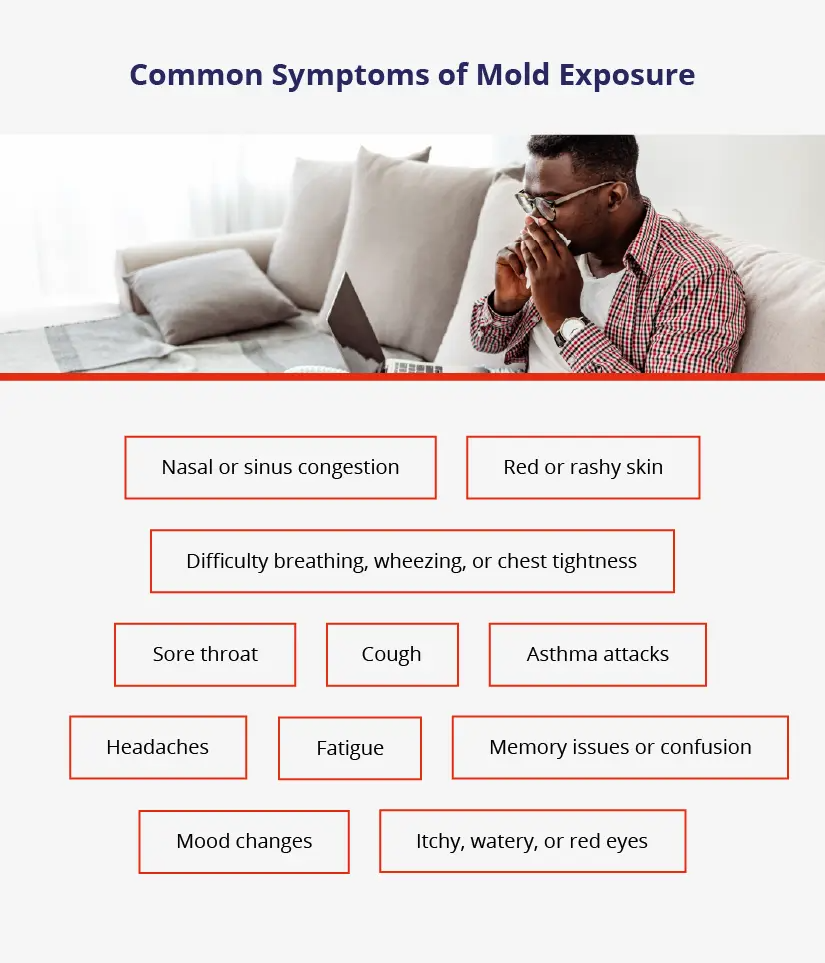
10. Aureobasidium
Aureobasidium is a mold that tends to change color as it ages. While it starts as a pink or brown hue, it transitions to black over time. Frequently found in damp environments, it should not be ignored due to its potential health implications.
What to know about Aureobasidium:
- What does it look like? Initially appearing pink or brown, Aureobasidium darkens to black as it matures.
- Where does it grow? It's commonly found on wooden surfaces, wallpaper, painted walls, and window frames, especially in damp conditions.
- How does it spread? Aureobasidium releases spores into the environment. These spores can attach to surfaces and objects or become airborne, colonizing new areas when they encounter favorable conditions.
- What health problems are linked to Aureobasidium? Exposure can lead to allergic reactions, including skin and eye infections. It's especially problematic for those with existing respiratory conditions.
11. Chaetomium
Chaetomium is particularly known for its distinctive musty odor. Found primarily in water-damaged homes and buildings, it's a mold type that requires immediate attention due to its potential health impacts.
What to know about Chaetomium:
- What does it look like? Chaetomium molds are typically cottony in texture and can vary in color from white to gray to brown.
- Where does it grow? It prefers water-damaged materials, particularly wet drywall, wallpaper, and baseboards.
- How does it spread? Chaetomium spreads through airborne spores, especially in environments with water damage. When these spores land on damp organic materials, they can start a new colony.
- What health problems are linked to Chaetomium? Exposure can result in skin and nail infections. Additionally, long-term exposure can lead to neurological and autoimmune symptoms.
12. Mucormycetes
Mucormycetes are a group of molds known for causing a severe infection called mucormycosis. Often associated with organic matter breakdown, these molds are opportunistic pathogens that can cause serious problems in immunocompromised individuals.
What to know about Mucormycetes:
- What does it look like? Mucormycetes molds are typically white to grayish in color with a fluffy or wooly texture.
- Where does it grow? They are commonly found on decaying organic materials, including compost piles, soil, and rotting wood.
- How does it spread? Mucormycetes spread through sporangia, which release spores into the environment. These spores can become airborne and will grow wherever they find the right conditions.
- What health problems are linked to Mucormycetes? Mucormycosis, the infection caused by these molds, can affect the sinuses, brain, lungs, and skin. It is particularly dangerous to individuals with compromised immune systems, diabetes, or those who've suffered skin trauma.
13. Serpula
Serpula, commonly recognized for causing dry rot in wood, is a mold type that compromises the integrity of wooden structures. Its creeping growth pattern and distinct coloration make it relatively easy to identify.
What to know about Serpula:
- What does it look like? Serpula is typically a bright yellow-orange or red-brown mold with a wavy and slightly fuzzy appearance.
- Where does it grow? This mold specializes in consuming wood, often found in wooden beams, floors, and structures, particularly those with a history of moisture issues.
- How does it spread? Serpula spreads mainly through direct wood-to-wood contact, though airborne spores can also lead to colonization of new areas, especially where there's persistent moisture.
- What health problems are linked to Serpula? While not as toxic as some other molds, Serpula can still cause allergic reactions in sensitive individuals. Its primary concern is structural, weakening wooden elements in buildings and potentially damaging the property.
14. Ulocladium
Ulocladium is a type of brown mold whose appearance can be deceptive. It’s often mistaken for other types of mold like Alternaria or Stachybotrys chartarum (black mold) due to its dark coloration. Thriving in extremely damp conditions, it's often an indicator of persistent water issues in homes and buildings.
What to know about Ulocladium:
- What does it look like? Ulocladium is black or dark gray and has a suede-like texture. Its colonies tend to be dense and can spread rapidly.
- Where does it grow? It's commonly found in kitchens, bathrooms, basements, or other areas prone to high humidity or water leaks.
- How does it spread? Ulocladium produces spores that can become airborne or attach to objects and surfaces. These spores can spread to other areas, especially in the presence of water or high humidity.
- What health problems are linked to Ulocladium? Exposure to this mold can cause respiratory problems, skin rashes, and eye irritation. Individuals with mold allergies may experience more severe reactions upon exposure.
15. Fusarium
Fusarium is a mold type that not only poses health risks to humans but also damages crops, especially cereals, making it a significant agricultural concern. It can thrive in cooler climates and spread rapidly, making prompt action crucial upon its discovery.
What to know about Fusarium:
- What does it look like? Fusarium typically appears in shades of pink, red, or purple. Its appearance may be wooly or cottony.
- Where does it grow? Commonly found in soil, Fusarium also grows on various plants and crops. Indoors, it can be found on water-damaged carpeting and other materials.
- How does it spread? Fusarium releases spores that can become airborne. These spores can then attach to surfaces or be inhaled by residents.
- What health problems are linked to Fusarium? Exposure can lead to a range of health problems, from skin infections to severe conditions like fusariosis, particularly in people with weakened immune systems. Inhalation can also cause allergic reactions and respiratory issues.
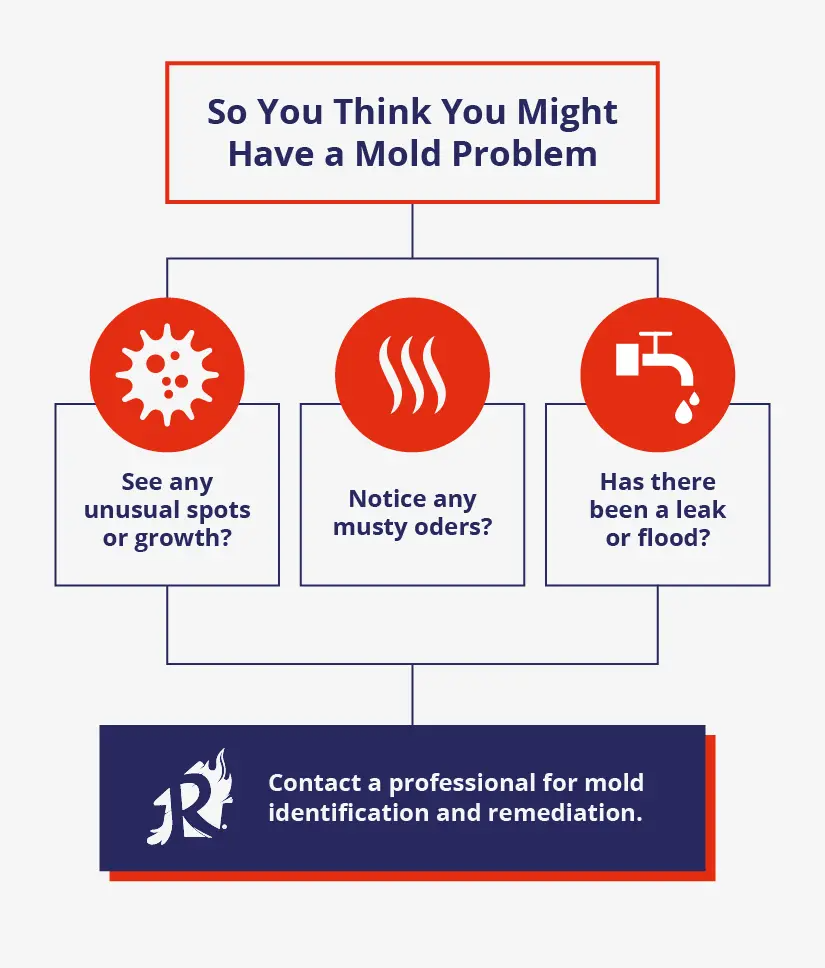
How To Test for Mold
While the internet is overflowing with DIY guides detailing how to check for mold, it's essential to understand that mold is not just a surface-level issue — it's an intricate challenge that warrants professional knowledge and experience.
Sure, spotting a dark patch or sniffing out a musty odor might seem like a straightforward task. But assessing the extent of mold contamination and its potential risks? That's a whole different ball game. Here are some tips to keep in mind if you think you may have a mold problem:
- Be observant: Often, there are visible signs of mold, like dark spots on walls or ceilings. Sometimes, however, the indications are more subtle, like a persistent musty odor.
- Avoid disturbing the mold: While it might seem counterintuitive, it's essential to avoid scrubbing or disturbing the mold, as this can release spores into the air, exacerbating the problem.
- Keep your distance: Though you may think that little dark spot may be harmless, you should exercise caution because airborne spores could still lead to potential health effects.
- Seek professional insight: If you're wondering how to test for mold, it's best to consult with professionals. They have the necessary equipment and expertise to provide an accurate assessment. The keyword here is accuracy. DIY mold testing kits are available, but their reliability is often questionable, and they may not provide a comprehensive understanding of the situation.
- Act quickly: Mold can spread rapidly, so it's essential to act as soon as you suspect its presence. Quick action can prevent further damage and potential health risks.
So, if you’re wondering how to test for mold, the most safe and straightforward answer is: enlist help.
The complexities surrounding mold growth, the potential dangers of certain mold types, and the risks associated with improper handling make it a task best left to professionals.
Expert mold inspectors are trained to not only identify and assess mold but to do so safely, ensuring the problem doesn't spread in the process.
How To Remove Mold
While some minor mold issues can be addressed on your own, hiring professionals ensures thorough removal, especially for larger infestations or dangerous mold types.
Here's how to tackle mold with expert assistance:
- Research local experts: Look for certified mold remediation specialists in your area with positive reviews and references.
- Consultation and inspection: Have the professionals inspect the infested area. They'll identify the mold type and the source of moisture.
- Discuss the plan: Understand the process and time frame to effectively remediate the mold. Ensure safety measures are part of the proposal.
- Let them work: Professionals will seal off the area, use specialized equipment to remove mold, and ensure proper disposal of contaminated materials.
- Post-treatment measures: Ask about preventive recommendations to avoid future mold growth.
- Regular monitoring: Keep an eye out for any signs of leaks and water damage, as these are primary contributors to mold development and schedule periodic checks with professionals to ensure that the mold has not returned.
Why You Should Work With a Professional for Mold Cleanup
Most at-home test kits are inaccurate — so inaccurate, in fact, that oftentimes their results aren’t even acknowledged by insurance providers or the courts.
Here’s why:
- Faulty materials: The test materials get contaminated by sitting on shelves in non-sterile environments, exposure to heat and humidity, or improper handling.
- No consistent lab standards: Most kits don’t include the control samples necessary for corroboration and don’t provide a controlled airflow to test for the correct number of mold spores. In addition, most tests only focus on growing mold but don’t account for the dead spores that can also negatively affect your health.
- No professional accreditation: The majority of DIY mold kits aren’t certified by any accredited agencies or labs. Since these agencies provide chain of custody standards, kits without accreditation are often missing important data necessary for accurate results.
- Misleading marketing: Although many DIY mold kits claim to be able to identify the type of mold you have, this is rarely true without spending additional time and money to send your samples to a lab for analysis. And even if your mold samples are analyzed by a credible lab, DIY kits usually provide inaccurate results.
In addition to being inaccurate, DIY mold testing can be dangerous because you must gather your own mold samples.
It may seem like a mask and gloves will give you enough protection, but unless you have the proper safeguards for your eyes, skin, and airways, mold can cause everything from eye and skin irritation to severe allergy and asthma attacks.
Plus, when gathering mold samples, you could also aggravate the colonies, spreading mold spores and making the problem worse.
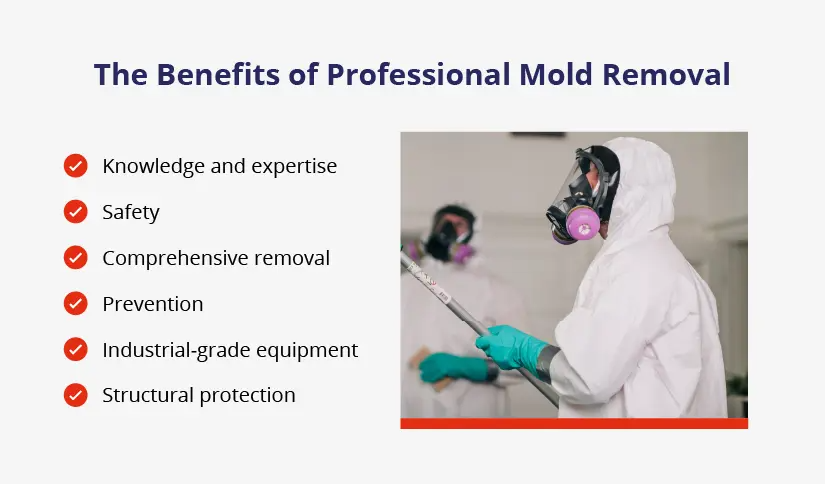
When you use a mold remediation company, you’re getting professionals who know how to accurately identify and remove the mold and prevent it from spreading or returning.
They’ll sample the air and various hard surfaces and then use those samples to grow cultures and find out what kind of mold you have and where it’s growing. Most importantly, they’ll use spore traps, swabs, tape, or other kinds of testing kits that meet American Industrial Hygiene Association (AIHA) standards to ensure accuracy.
Mold remediation specialists won’t just test the mold you can see; they’ll also look for concealed sources of mold. Locating hidden water intrusion and identifying sources of moisture allows them to see what may be causing or contributing to indoor mold growth.
They’ll check obvious sources of moisture like leaking pipes, plus more subtle sources of mold-producing moisture like condensation in HVAC systems and ductwork. Unlike the DIY homeowner, these professionals have the proper tools to safely find and identify all types of mold.
FAQ About Mold
What Is the Most Common Mold?
Both in homes and businesses, the most common type of mold is Cladosporium. This mold can be found both indoors and outdoors and grows on a variety of materials, including textiles, wood, and other organic substances. While it's more frequently spotted in homes, especially in bathrooms, kitchens, and basements, Cladosporium is not a stranger to commercial settings, often lurking in damp areas or places with poor ventilation.
What Is the Most Dangerous Mold?
Stachybotrys chartarum, commonly referred to as "black mold," is often labeled as the most dangerous mold. While all molds can present health risks, black mold is notorious for producing mycotoxins that can lead to a range of health issues, from respiratory distress to neurological problems. Prompt identification and removal are vital to safeguard health.
How Can I Tell What Kind of Mold I Have?
Identifying the specific type of mold in your property or business can be challenging without expert help. While some molds may have distinct colors or patterns, many look alike. Professionals use specialized equipment and testing methods to determine mold types accurately. If you suspect mold in your business establishment, it's essential to get it identified and treated promptly to ensure the safety of both employees and customers.
Can Mold Be Identified Visually?
While certain types of mold may have characteristic appearances that give a clue to their identity, a visual inspection alone is not a reliable method for mold identification. Many molds share similar colors or textures, and what may look like one type could be another. Plus, some molds might be lurking beneath surfaces, making them invisible to the naked eye. A professional mold inspection is the most reliable way to identify and treat mold.
Is There an App To Identify Mold?
Yes, there are several apps and online platforms that claim to help users identify mold based on pictures. Some government agencies might also offer digital resources to help people get preliminary insights into potential mold issues. However, these tools should be used with caution. No app can replace the accuracy and reliability of a professional mold inspection. If you believe you have a mold issue, it's always best to consult with professionals for definitive identification and action.
What Can Be Mistaken for Mold?
There are several substances and occurrences that can be mistaken for mold. Efflorescence, a white, powdery substance found on bricks or concrete, is often confused with white mold. Dust, dirt, or soot can sometimes accumulate in patterns that resemble mold growth. Additionally, some wall stains resulting from water damage might not be mold but can be precursors to mold growth. When in doubt, it's always wise to have a professional evaluate the situation.
The Rainbow Restoration® Difference
Dealing with mold requires more than just a quick cleanup. In order to protect your home or business, you need to cut the problem off at the source. And that’s exactly what Rainbow Restoration can do for you.
Here's what sets us apart:
Expertise: Our comprehensive assessments are more than just evaluations — they're the first step in our dedicated plan of attack to reclaim your space
Precision: Using state-of-the-art tools and techniques, our service professionals meticulously target and treat every mold issue with surgical precision.
With Rainbow Restoration, you get complete eradication the first time around, saving potential costs down the line.
Don't let mold disrupt your peace of mind. Choose Rainbow Restoration for a cleaner, healthier, and more vibrant space.
To learn more about professional black mold removal and remediation services, contact Rainbow Restoration to request an appointment online or find a location near you.
This article is intended for general informational purposes only and may not be applicable to every situation. You are responsible for determining the proper course of action for your property. Services should be performed by licensed and experienced professionals. Rainbow Restoration is not responsible for any damages that occur as a result of this blog content or your actions. For the most accurate guidance, contact a Rainbow Restoration professional for a custom, on-site assessment.
